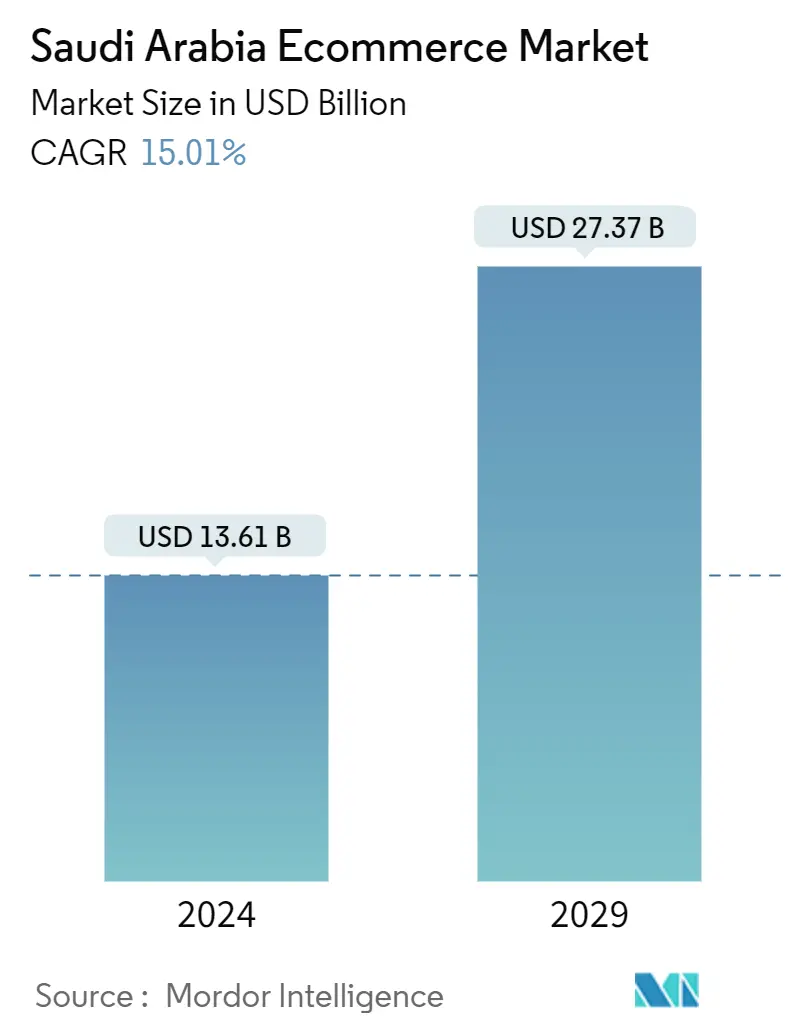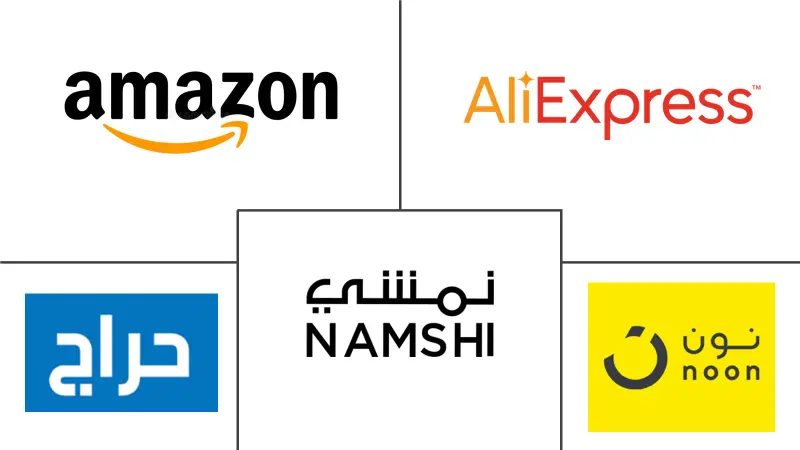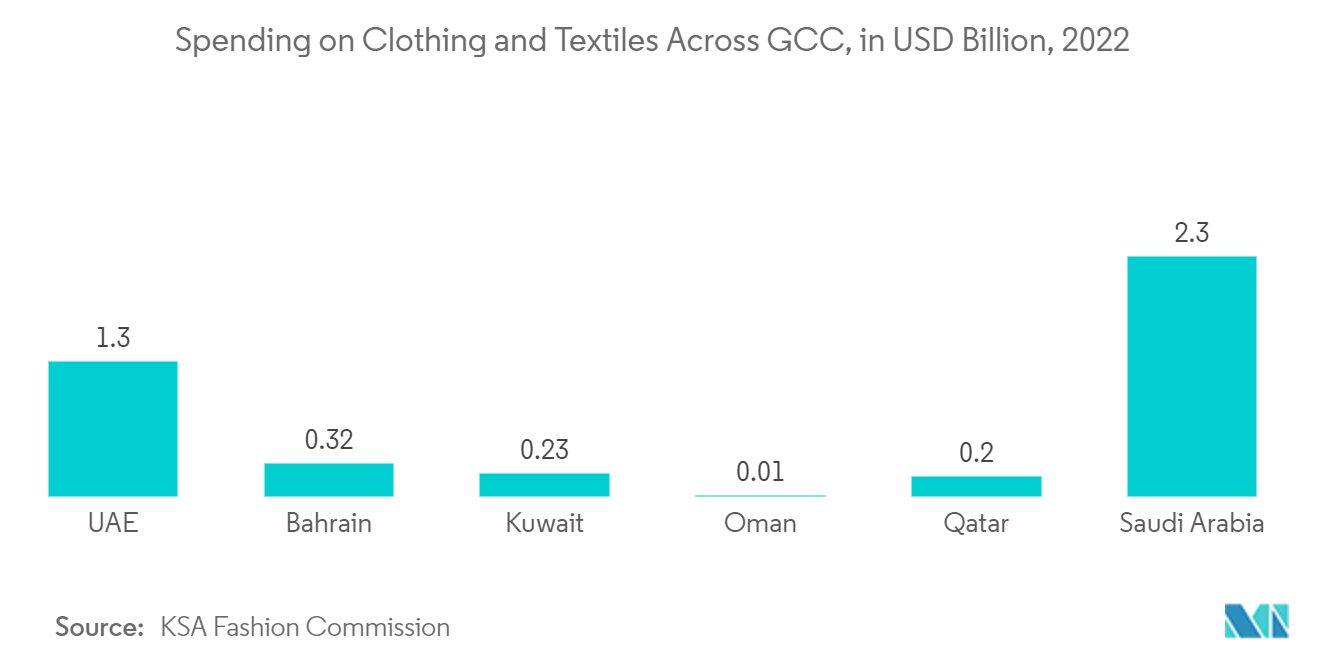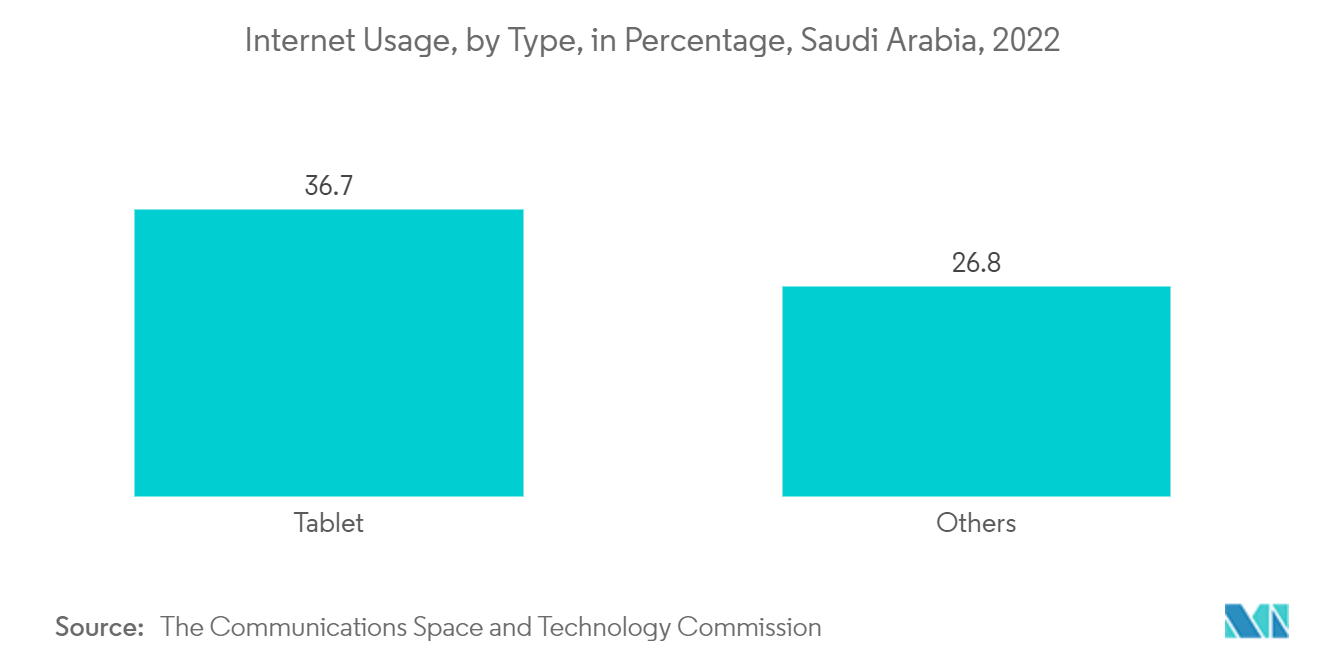Saudi Arabia E-Commerce Market Size

| Study Period | 2019 - 2029 |
| Base Year For Estimation | 2023 |
| Market Size (2024) | USD 13.61 Billion |
| Market Size (2029) | USD 27.37 Billion |
| CAGR (2024 - 2029) | 15.01 % |
| Market Concentration | Low |
Major Players
*Disclaimer: Major Players sorted in no particular order |
Saudi Arabia E-Commerce Market Analysis
The Saudi Arabia Ecommerce Market size is estimated at USD 13.61 billion in 2024, and is expected to reach USD 27.37 billion by 2029, growing at a CAGR of 15.01% during the forecast period (2024-2029).
The market analyzes the revenue generated by selling goods such as food and beverage, consumer electronics, fashion and apparel, beauty and personal care, furniture and home, and others through the online sales channel.
- Saudi Arabia has a developed economy, and internet penetration is significant in the nation, with the World Bank indicating that over 100% of the population uses the internet. This indicates that the awareness of online shopping is significant and contributes to market growth. The growing advancements in mobile internet technologies, smartphones, and broadband have boosted the adoption of internet-based services.
- Moreover, the growing government aid in boosting the adoption of digital technologies in the nation in line with the Vision 2030 plan is analyzed to contribute to the market growth rate during the forecast period. For instance, in September 2022, the Ministry of Commerce launched ten initiatives to develop e-stores in Saudi Arabia. The ministry stated that the ten initiatives had been set in accordance with the people's suggestions to develop this sector.
- The growing collaborations in the nation are also contributing to the market growth rate. For instance, in 2022, the Middle East's Apparel Group and FSN E-commerce, the parent company of the online fashion store Nykaa, struck a contract to enter the Gulf market. To provide differentiated Gulf Cooperation Council (GCC)-oriented beauty offerings in the United Arab Emirates, Saudi Arabia, Qatar, Oman, Kuwait, and Bahrain, Nykaa will leverage the Apparel Group's retail infrastructure network and extensive market relationships. The GCC is positioned for rapid growth, particularly in the personal care and cosmetics sectors. With the Apparel Group, Nykaa has a significant chance to broaden its core value proposition and accelerate regional offline and online retail growth.
- As more individuals in Saudi Arabia use e-commerce for their shopping, this increases the opportunity for scammers to take advantage of vulnerable customers. According to Arabian Business, 93% of financial fraud occurred after the pandemic, which supports the fact that cybercrime activity is rapidly increasing. This is expected to challenge the growth of the market.
- However, consumers' interest in e-commerce also increased significantly post-pandemic. The COVID-19 pandemic significantly increased online product sales due to governmental restrictions, lockdowns, and safety purposes; it became the new normal as companies and customers went digital by offering products and services through e-commerce channels during the pandemic in Saudi Arabia. Restrictions on movement and trade due to the COVID-19 pandemic led to a substantial shift in consumer behavior in the Kingdom, with locals increasingly turning to digital channels.
Saudi Arabia E-Commerce Market Trends
Fashion and Apparel Segment is Expected to Grow Exponentially
- The fashion and apparel segment contributes a significant share of the revenue generated through the e-commerce offerings of the market vendors in the country. The clothing and fashion industries include many textiles and other outfits such as shoes, watches, jewelry, eyewear, bags, and accessories, including products for men, boys, women, and girls. Despite restrictive social norms governing dress and appearance, interest and intent thrive for both men and women.
- The Saudi Arabian Fashion Commission contributed to the nation's sustainability by developing the fashion industry through its 100 Saudi Brands initiatives and establishing the Saudi Professional Fashion Association. This initiative aims to develop 100 Saudi designers and premium brands to expand their businesses. This may increase the demand for e-commerce in the country, as e-commerce can be used to market the products.
- The global fashion e-commerce company has been expanding its market presence in the country, which shows the market potential in the country. For instance, in October 2022, the parent company of omnichannel retailer Nykaa, FSN International, formed a strategic partnership with the Middle Eastern Apparel Group to expand into the Gulf Cooperation Council (GCC) region, which includes Saudi Arabia.
- In March 2023, Amazon made it easy for Saudi businesses to access millions of new customers by offering its global registration system throughout the Kingdom. Along with information on units, inventory, and prices, the seller center would guide sellers in interacting with customers and increasing interaction in various product segments, including the fashion and apparel sectors. Fashion e-commerce companies have been raising funds to increase their market presence in the country's emerging e-commerce market, which may fuel market growth during the forecast period.
- According to the IMF, the country has registered a high individual net income, supported by its high per capita GDP, estimated to grow further. The growth in per capita GDP may increase the purchasing capacity of individuals in the country, which is expected to create an upsurge in demand for the fashion and apparel industries. This is expected to drive the growth of the e-commerce market in the country.

Beauty and Personal Care Segment is Expected to Hold Significant Share
- The beauty and personal care segment includes a broad range of product categories, like cosmetics and fragrances, over-the-counter (OTC) pharmaceuticals, body and hair care products, tissue and hygiene paper, hand sanitizers, etc. Many global skincare companies are expanding their business by implementing e-commerce sales channels to increase their market presence, which may create an opportunity for market vendors.
- For instance, in January 2023, Happier Skincare, an Indian skincare company, planned to expand its business in the country. The company may adopt e-commerce expansion in the region, focusing on Saudi Arabia, which retails on several multi-brand marketplaces, including Amazon and its dedicated online store.
- Additionally, the officials of L'Oreal Middle East have stated in a forum that the customers in the country spend comparatively more money on their looks, supporting the market for cosmetics and fragrances as it continues to expand rapidly. These factors may drive the growth of e-commerce for beauty and personal care in the country.
- The country is a significant market for fragrances due to its high per capita income and rich culture. The Saudi Arabian market for high-end cosmetics and perfumes is expanding as the industry aims to appeal to upper-class consumers. For instance, Hermes opened its first fragrance and cosmetics shop in Saudi Arabia in July 2022. The increasing demand for perfumes may propel luxury fragrance brands to go for omnichannel sales, which can fuel the market in the country.
- Startups and small and medium-sized businesses in the Kingdom have taken advantage by entering the internet space and utilizing resources, like social media, to increase sales and broaden their clientele. New e-commerce companies can increase their market presence by opting for various social media platforms to avoid the advertisement expenses of their brands, which may increase the market in the country.
- Consumers in the Kingdom's Gen Z and Millennial generations are becoming more concerned with product ingredients, and there is an increasing demand for cosmetics that are organic, vegan, and made with ethical production practices. In addition, the country has been hosting beauty care product events, including Beautyworld Saudi Arabia, whose 3rd edition was organized in March 2022. These factors may increase the demand for such products in the country and create an opportunity for the e-commerce players in the country.

Saudi Arabia E-Commerce Industry Overview
Saudi Arabia's Ecommerce Market is witnessing a rise in competitiveness among companies. The market consists of various major players, such as Amazon, Haraj, Noon A.D. Holdings Ltd, Namshi General Trading L.L.C., and Aliexpress. In terms of market share, these significant players are presently dominating the e-commerce market in Saudi Arabia. However, with increasing innovations in e-commerce, many companies and startups are increasing their market presence by securing new contracts and tapping new markets.
In May 2023, Amazon inaugurated its latest Fulfillment Center in Riyadh, Saudi Arabia, with the growing e-commerce market in the country. The facility spans 390,000 square feet across five floors that are approximately the size of five football fields. Moreover, the center is expected to store over 9 million products, facilitating Amazon to delight customers with a wider selection of products across electronics, appliances, groceries, fashion, books, and more.
In April 2023, Noon A.D. Holdings Ltd (Noon E-Commerce) introduced Noon One, which provides customers with a simple way to save money on purchases. It has been designed as an upgraded loyalty scheme, which offers members unlimited free delivery on all the app products and encourages them to shop more frequently.
Saudi Arabia E-Commerce Market Leaders
-
Amazon.com, Inc
-
Haraj
-
Noon AD Holdings Ltd
-
Namshi General Trading L.L.C
-
Aliexpress
*Disclaimer: Major Players sorted in no particular order

Saudi Arabia E-Commerce Market News
- February 2023: The online fashion retailer Namshi, which operated primarily in Saudi Arabia, was acquired by the e-commerce company Noon for a total cash consideration of USD 335.2 million, and this addition of more fashion and lifestyle brands to Noon's digital offering of goods and services in the country
- December 2022: Sideup, an e-commerce platform developer, received USD 1.2 million in funding from local and international investors. The business was to use its investment funds to expand its operations in Saudi Arabia and shift its headquarters to Riyadh as part of its plans for Saudi Arabia.
Saudi Arabia E-Commerce Market Report - Table of Contents
1. INTRODUCTION
- 1.1 Study Assumptions and Market Definition
- 1.2 Scope of the Study
2. RESEARCH METHODOLOGY
3. EXECUTIVE SUMMARY
4. MARKET INSIGHTS
- 4.1 Market Overview
-
4.2 Industry Attractiveness-Porter's Five Forces Analysis
- 4.2.1 Bargaining Power of Suppliers
- 4.2.2 Bargaining Power of Buyers/Consumers
- 4.2.3 Threat of New Entrants
- 4.2.4 Threat of Substitute Products
- 4.2.5 Intensity of Competitive Rivalry
- 4.3 Key Market Trends and Share of E-commerce of Total Retail Sector
- 4.4 Impact of COVID-19 on the E-commerce Sales
5. MARKET DYNAMICS
-
5.1 Market Drivers
- 5.1.1 Increase in Internet Penetration and Smartphone Usage
- 5.1.2 Promotion of E-commerce by the Government Sector, including Measures to Strengthen Last-Mile Delivery and Improvise Distribution Centers
-
5.2 Market Challenges
- 5.2.1 Increasing Incidents of Cybercrime, Fraudulent Transactions on E-commerce Platforms
- 5.3 Analysis of Key Demographic Trends and Patterns Related to the E-commerce Industry in Saudi Arabia (Coverage to Include Population, Internet Penetration, E-commerce Penetration, Age & Income, etc.)
- 5.4 Analysis of the Key Modes of Transaction in the E-commerce Industry in Saudi Arabia (Coverage to Include Prevalent Modes of Payment, such as Cash, Card, Bank Transfer, and Wallets)
- 5.5 Analysis of Cross-border E-commerce Industry in Saudi Arabia (Current Market Value of Cross-border & Key Trends)
- 5.6 Current Positioning of Saudi Arabia Country in the E-commerce Industry in the Middle East
6. MARKET SEGMENTATION
-
6.1 By Type
- 6.1.1 B2C E-commerce
- 6.1.1.1 Market Size (GMV) Estimates and Forecasts
- 6.1.1.2 Market Segmentation - by Application
- 6.1.2 B2B e-commerce
- 6.1.2.1 Market Size (GMV) Estimates and Forecasts
7. COMPETITIVE LANDSCAPE
-
7.1 Company Profiles*
- 7.1.1 Amazon.com Inc.
- 7.1.2 Haraj
- 7.1.3 Noon Ad Holdings Ltd. (Noon E-Commerce)
- 7.1.4 Jazp.com
- 7.1.5 Aliexpress
- 7.1.6 eBay Inc.
- 7.1.7 Namshi General Trading L.L.C
- 7.1.8 Carrefour
8. INVESTMENT ANALYSIS
9. FUTURE OUTLOOK OF THE MARKET
** Subject To AvailablitySaudi Arabia E-Commerce Industry Segmentation
The Saudi Arabian e-commerce market is defined based on the revenues generated from the sales of various end-user applications, such as food, beverage, consumer electronics, fashion and appraisal, beauty and personal care, furniture, home, and other end users. The analysis is based on market insights captured through secondary and primary research. The market also covers the major factors impacting its growth in terms of drivers and restraints.
The Saudi Arabia e-commerce market is segmented by type (B2B e-commerce, applications (beauty and personal care, consumer electronics, fashion and apparel, food and beverage, furniture, and home), and B2B e-commerce). The market sizes and forecasts are provided in terms of value in USD for all the above segments.
| By Type | B2C E-commerce | Market Size (GMV) Estimates and Forecasts |
| Market Segmentation - by Application | ||
| By Type | B2B e-commerce | Market Size (GMV) Estimates and Forecasts |
Saudi Arabia E-Commerce Market Research FAQs
How big is the Saudi Arabia Ecommerce Market?
The Saudi Arabia Ecommerce Market size is expected to reach USD 13.61 billion in 2024 and grow at a CAGR of 15.01% to reach USD 27.37 billion by 2029.
What is the current Saudi Arabia Ecommerce Market size?
In 2024, the Saudi Arabia Ecommerce Market size is expected to reach USD 13.61 billion.
Who are the key players in Saudi Arabia Ecommerce Market?
Amazon.com, Inc, Haraj, Noon AD Holdings Ltd, Namshi General Trading L.L.C and Aliexpress are the major companies operating in the Saudi Arabia Ecommerce Market.
What years does this Saudi Arabia Ecommerce Market cover, and what was the market size in 2023?
In 2023, the Saudi Arabia Ecommerce Market size was estimated at USD 11.57 billion. The report covers the Saudi Arabia Ecommerce Market historical market size for years: 2019, 2020, 2021, 2022 and 2023. The report also forecasts the Saudi Arabia Ecommerce Market size for years: 2024, 2025, 2026, 2027, 2028 and 2029.
Saudi Arabia E-Commerce Industry Report
Statistics for the 2024 Saudi Arabia E-Commerce market share, size and revenue growth rate, created by Mordor Intelligence™ Industry Reports. Saudi Arabia E-Commerce analysis includes a market forecast outlook to 2029 and historical overview. Get a sample of this industry analysis as a free report PDF download.



